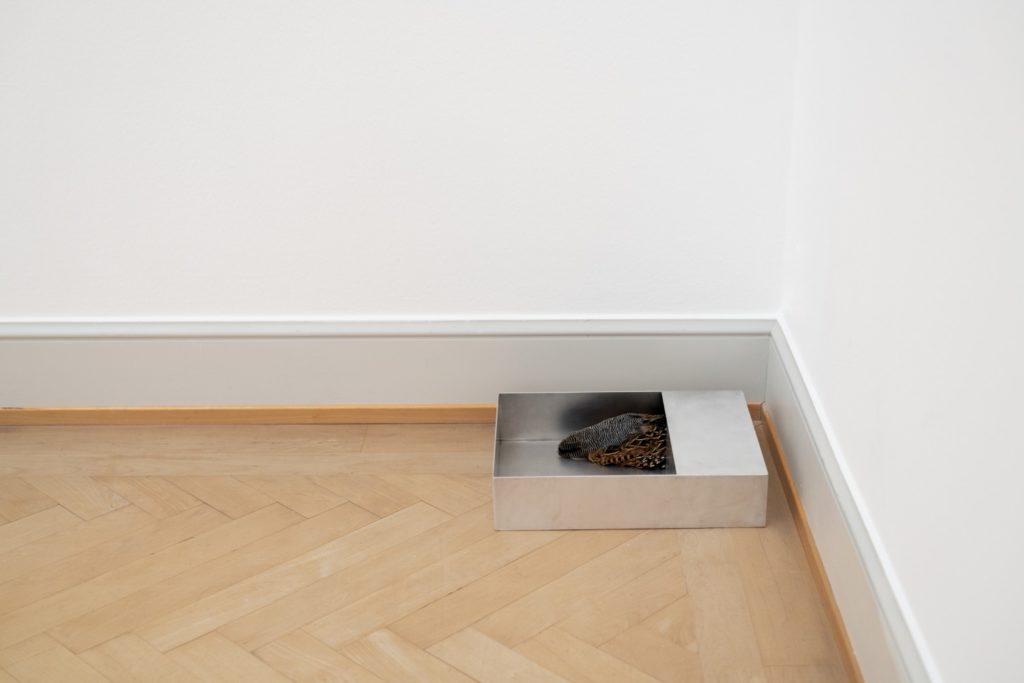silentstar, delicacy
2020 - Sculpture (Sculpture)
142.24 x 50.8 x 12.7 cm
Duane Linklater
silentstar, delicacy by Duane Linklater is a replica of a baby pink hoodie that the artist wore as a teenager, embellished with hand-painted elements and band patches. From associations with punk and hip-hop to skater culture, the hoodie has a history of being adopted by youth-driven communities once relegated to the fringes, and being embraced by mainstream fashion as a practical article of clothing, which Linklater’s work complicates even further. The reproduction is made with dye extracted from cochineal insects. Cochineal is a product of Indigenous technology developed for the Aztec and Maya long before the arrival of the Spanish. Europeans coveted the deep, rich carmine that was brighter and more durable than any other red dye, and began exploitation of the resource. By the 17th century, cochineal had become one of the world’s first globalized products. Linklater’s work speaks to histories of colonialism and cultural appropriation of Indigenous knowledge and representations in consumer culture, especially in the fashion industry that explicitly appropriates Indigenous traditions and imagery in its design. Linklater’s hoodie also includes one silk-screened image in blue on the front, a common design and often-customizable feature in the fashion industry. The image is a distorted film still from The Daughter of Dawn , a 1920s silent film shot in Oklahoma with an all-Indigenous cast of more than three hundred Kiowa and Comanche actors. Despite its contrived storyline centering on a love triangle involving the Kiowa chief’s daughter, Linklater sees the film as an extraordinary document on Indigenous communities and Indigenous land rights.
Duane Linklater addresses issues of cultural loss and recovery, as well as appropriation and authorship articulated through sculpture, installation, photography, film, and video. Linklater challenges the physical and ideological structures of settler-colonialism and reconsiders oral traditions of knowledge sharing in communities where the transmission of cultural wisdom and histories is critical for future generations. In 2011, Linklater initiated Wood Land School, a nomadic, artist-driven project that situates Indigenous forms and ideas within the institutional spaces that each session inhabits. During residencies at the Banff Centre in the following year, Linklater and sculptor Brian Jungen created the acclaimed film Modest Livelihood . Part of DOCUMENTA (13) , it follows the artists on a hunting trip, referencing their desires to reclaim ancestral knowledge. Linklater’s research on the language and traditional territory of Newfoundland’s extinct Beothuck people forms another project in this vein, while his performances and frequent collaborations with other artists and educators aim to create conditions and spaces for Indigenous voices and ideas within historic sites of marginalization, such as the museum, the gallery, and the biennial.
Colors:
Related works sharing similar palette

© » ARTS EQUATOR
Weekly Southeast Asia Radar: The animated short 'Batik Girl'; Manila's "casserole pot" | ArtsEquator Thinking and Talking about Arts and Culture in Southeast Asia ArtsEquator Radar Batik Girl FB November 21, 2019 ArtsEquator’s Southeast Asia Radar features articles and posts about arts and culture in Southeast Asia, drawn from local and regional websites and publications – aggregated content from outside sources, so we are exposed to a multitude of voices in the region...

© » KADIST
Michelle Handelman
2009In Dorian, a cinematic perfume, video is used as a community gatherer, a tool to speak about particular subcultures, in this case the trans-gender drag queen New York community, past and present...

© » KADIST
Yoan Capote
2007Open Mind is a model created by Capote for a traversable public maze that, when seen from above, resembles the human brain...

© » ARTS EQUATOR
Podcast 61: The Media Landscape in Thailand | ArtsEquator Thinking and Talking about Arts and Culture in Southeast Asia Articles Asian Arts Media Roundtable July 11, 2019 Duration: 20 min In our latest podcast, Thai theatre critic Amitha Amranand gives a comprehensive overview of the media landscape in Thailand, discussing the impact of the political and legal system on the arts and the paradoxical freedom that arts journalists have in the country...

© » KADIST
Oren Pinhassi
2020Oren Pinhassi’s work examines the relationship between the human figure and the built environment...

© » KADIST
Karl Haendel
2011Haendel’s series Knights (2011) is a set of impeccably drafted, nine-foot-tall pencil drawings depicting full suits of armor...

© » KADIST
Felipe Arturo
2012Primero estaba el mar ( First Was the Sea , 2012) is a system of equivalences between syllables and silhouettes of waveforms cast in cement...

© » DAZED DIGITAL
How cute became the defining aesthetic of the internet age | Dazed â¬…ï¸ Left Arrow *ï¸âƒ£ Asterisk â Star Option Sliders âœ‰ï¸ Mail Exit Life & Culture Feature From emojis to coquettes and Hello Kitty, cute’s transformative potential is shaping how we see ourselves both on and off-screen Text Günseli Yalcinkaya 9 February 2024 Cute (2024) 13 When Tim Berners-Lee, the inventor of the World Wide Web, was asked in 2014 to name one use of the internet that he didn’t anticipate, he answered with a single word: kittens...

© » KADIST
Dale Harding
2018Dale Harding’s installation Body of Objects consists of eleven sculptural works that the artist based on imagery found at sandstone sites across Carnarvon Gorge in Central Queensland...

© » KADIST
Milena Bonilla
2009Milena Bonilla’s discursive practice explores connections among economics, territory, and politics through everyday interventions...

© » KADIST
Gan Chin Lee
2019In Studies of Chinese New Villages II Gan Chin Lee’s realism appears in the format of a fieldwork notebook; capturing present-day surroundings while unpacking their historical memory...

© » KADIST
Pablo Rasgado
2011Pablo Rasgado’s paintings and installations serve as a visual record of contemporary urban human behavior...

© » KADIST
Zach Reini
2015Particularly shaped by his own youth in the 1990s, his recent works have incorporated things like a marijuana leaf, a dragon-emblazoned chain wallet, metal grommets, and the ubiquitous (in the 90s) Stussy symbol...







